On December 17, 1947, Boeing’s B-47 Stratojet took to the skies. The era of the jet-bomber had commenced, and the Russians had nothing. Of course, it’s no question to those familiar with Soviet aviation politics of the era to assume who was given the order to directly counter the B-47. For those of you less familiar, it was Andrei Tupolev. Using the TsAGI (Central Aerohydrodynamic Institute) data that would later beget the creation of the Tu-95, Tupolev would create the wildly-successful Tu-16. This would have been sufficient if it was not immediately apparent that the Americans and the English were working on jet bombers with truly intercontinental range. Stalin demanded parity with the West by any means necessary.
What resulted was something rather surprising. His trusty servant Tupolev replied with something slightly more rude than “excuse me, I am busy working on the Tu-16 and the Tu-80 right now – I can’t work miracles.” Standing up to Stalin was, in general, a bad idea. So Stalin came back and offered to give this project “All Union” importance. Tupolev continued to turn him down. The real reason behind Tupolev’s refusal was that he simply did not trust the state of Soviet turbojet technology’s abilities to create a truly intercontinental bomber. Fast way to an early retirement in Crimea, for most.
Tupolev had been navigating Stalin’s madness since his rise to power – he knew better. He had supporters within the Ministry of Aircraft Production, who also vouched for his suspicions. Tupolev, thus, was allowed to continue with his other projects. Someone, however, had to take up the mantle of intercontinental jet bomber designer.
Vladimir Myasischev was no slouch. Trained under Tupolev, he worked on aircraft as bizarre and giant as the ANT-20. He worked directly with Lisunov on making the DC-3 more Russia-friendly. He was even imprisoned in the same gulag as his former boss Andrei Tupolev. He would eventually go on to become dean of the Moscow Aviation Institute, and culminate his career as chief of TsAGI (sort of like NASA without the S).
Myasishchev was developing bombers in parallel with his tutor Andrei Tupolev in 1944. Where did his design bureau go? Running a second-tier OKB (Experimental Design Bureau) was a situation in which one day you had an OKB and the next day it was taken away for some minor impertinence.
Back as a more pure academic, Myasishchev quickly ran afoul of the party while head of aircraft design at the Moscow Aviation Institute. Demoted to “head of fixed wing aircraft,” Myasishchev began researching, for the time, state-of-the-art aircraft, all of them jet-powered. Eventually, he would devise a fairly-conventional platform aircraft based around four Mikulin AM-3 turbojet engines (the same engine used in the Tu-16).
This aircraft would have a maximum take-off weight of 140 tons, and be capable of carrying a useful payload 7,456 miles. The wing would have a cranked configuration with the inner portion being swept 45º and the remainder 40º. The only unconventional feature was that this aircraft would be configured with bicycle landing gear with outriggers mounted in fairings on the wingtips.
Since this study was born in academia, for the project to be taken further it had to first gain sign off from TsAGI, then the Ministry of Aircraft Industry. If that wasn’t enough, the council of ministers also had to approve of it. However, since it was an intercontinental, turbojet-powered strategic bomber it was not a hard sell. So crucial was this design that Myasishchev was returned to the position of running his own design bureau.
This time, the scope of his bureau was to design heavy bombers and, almost in the margins, special mission aircraft. The aircraft design that sparked the reopening was given the same priority as was promised to Tupolev. It also came with a deadline. The first flight had to occur in December of 1952 (a little over a year after formation of the OKB), and the second aircraft had to fly one year later, with improved performance.
The largesse of this project was like none ever seen before. The entire 1951 graduating class of the Moscow Aviation Institute were sent to Myasishchev. He and his deputies were given permission to take engineers from other design bureaus. Even the Ministry of Aircraft Industry wondered if so many resources were needed — especially as organizational work ate up much of the precious time to design aircraft “M.”
By April of 1952, most of the organizational hurdles had been overcome; the aircraft had also lost its bizarre cranked configuration. The wing was changed to something more conventional with a 30º sweep. By June of that year, the design edict from the government had also been clarified. Aircraft M was to have a crew of eight, four engines, be able to carry a maximum of 24 tons of payload, cruise at mach 0.75 or higher, and fly over targets at an altitude of 36,000 feet.
The lower wing area of aircraft M would explain the lower cruise altitude than its American counterpart, the B-52. This lower altitude also would demand the installation of defensive armament. Curiously missing from the design was any sort of creature comfort for the crew on their potentially thirteen-hour missions. Not that Myasishchev was alone in this; the first bomber to actually feature something as simple as a lavatory was the Tu-95MS.
Given the state of Soviet jet engines, there was never any real question of propulsion. As the original white paper had stated, Mikulin’s AM-3 remained the necessary component.
In other words, the aircraft began to look very similar to the one in the above image.
As you can also probably see, the bicycle undercarriage configuration was kept. Why? Well, there was a vague amount of data to support that a bicycle configuration of two wheel-trucks consisting of four wheels each was better for taking off and landing on underprepared airfields. Little consideration was given to things like how the aircraft would steer until after the configuration was already set in stone. Steering aircraft “M” was more akin to that of a semi-trailer. The front bogey would pivot, and the aircraft would rotate around it.
Furthermore, rather than rotating like a conventional aircraft, a procedure by which pilots pull back on the control yoke, aircraft “M” used a system where the nosewheel would tilt and elevate the nose of the aircraft, which increased the angle of attack. Naturally, the steering function had to lock when this was engaged. If that was not enough, this idiosyncrasy prompted Myasishchev to design a primitive, automatic, take off system. Much of the initial training for the test pilots centered around them being reminded to not pull back on the stick when the aircraft reached rotation speed. An extremely counterintuitive procedure.
To continue flying in the face of logic and convention, the aircraft would also feature ejection seats. Not the ejection seats that were of world-acclaim designed by Zvezda, but an in-house design. Why? For reasons that are still a matter of debate, aircraft M’s evacuation system would eject all the crew out of one hatch. Because of this, the ejection seats had to be capable of automatically moving to this point in a very specific sequence.
Despite all the unique features and the very short development window, a test article was ready right on time in December of 1952. It was transported, in pieces and carefully camouflaged under non-obvious tarps, down the Moscow River to the flight test facility at Zhukovsky.
The aircraft, now designated M-4, took to the skies for the first time on January 20, 1953. The flight tests began to illustrate both some aerodynamic quirks and issues with the all-new hydraulic control system. Most worryingly, though, was how on the thirteenth test flight, an elevator fell off. The aircraft landed safely, but the cause was alarming. The first prototype was 25 tons overweight, and to get back to the ideal weight of 155 tons, the designers did whatever they could to put the aircraft on a diet. One overenthusiastic team had decided to make the elevator skins so thin that the flight forces caused them to fail after, apparently, no more than thirteen flights.
With the second test article joining the fleet in December of 1953, testing was going slower than the government had hoped. In fact, the bar had to be moved by the ministry of aviation twice to prevent Myasishchev from missing the official deadline. The aircraft were, finally, handed over for state acceptance trials on March 30th, 1954.
Instead of immediately undergoing testing, two weeks were spent rehearsing for a surprise formation flypast above Red Square for the May Day celebrations that year. When the flypast occurred, foreign diplomats gazed upon the M-4 with a sense of both awe and horror. The Soviets were clearly building a fleet of strategic bombers that could darken the skies over America.
Testing was proving to be a disappointment. The furthest the aircraft could fly with even a five-ton payload was 6,090 miles. That was only true if the aircraft entered the landing pattern with two engines shut down. The range, in all actuality, was more likely to be a maximum of 5,900 miles. Myasischev balked at these figures, arguing that the state testing was not using full production aircraft and they’d get it better next time.
While the M-4 was a whole 35-miles-per-hour faster than its arch rival, the Tu-95, the Tu-95 could carry its payload 3,000 more miles. Despite this, the Soviet press always painted an extremely rosy picture of what NATO called the “Bison.” They would say it was superior in all ways to the “old technology” Tu-95, while in secret constantly improving the former.
In the end, very few M-4s were actually built.
The M-4s that were constructed were used as an elaborate piece of military deception (aka maskirovka) in 1955. With the Western delegations always invited to Aviation Day at Tushino, it was time to play a trick. Two waves of M-4s would fly by the crowd. The first wave would consist of ten M-4s and the second would be joined by another eight. Western analysts assumed that this meant there were more than 28 M-4s in service and that the Soviets would be able to field 800 of these aircraft by 1960. Terrified, they called this the “bomber gap.”
A Bison that came closer to matching the original requirements first flew on March 27, 1956. It wasn’t an M-4 any more because, in reality, it only looked like one superficially. Dubbed the 3M, this aircraft was powered by the all-new Dobrynin VD-7 engine and managed to weigh a full 14,000lbs less than its predecessor. The payload remained the same, but the 3M lost two defensive turrets as well as a crew member. With the rapid improvements in technology, the gunner was also replaced by an electronic warfare officer. While it still could not reach Washington DC, it was a much more tactically sound aircraft.
The 3M was also capable of in-flight refueling. From what? That’s the amusing part. The original M-4s were, quietly, withdrawn from strategic bomber service. It was discovered that removing all the war equipment from an M-4 allowed it to carry a remarkable amount of fuel. Dubbed the M-4-2, these tankers released their drogue from a spool in what was once the bomb bay.
Unfortunately, the 3M was almost canceled before it entered production. Not only was the Tu-95 improving so much, but there were two, identical fatal crashes in testing. The landing gear would fail during elevation for take off, sending the plane into the ground at high velocity.
By the time the 3M entered service, nuclear warfare was changing. Even though early Intercontinental Ballistic Missiles (ICBMs) took longer to prepare to launch than it would for a strategic bomber mission to reach its target, there was clear potential. Combined with the growing integrated air defense networks of Canada, the United States, and Western Europe, the days of free-fall nuclear bombing were coming to a close.
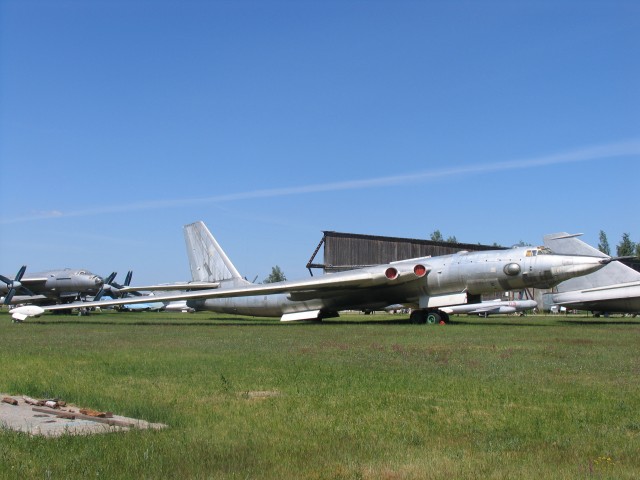
Perhaps the only surviving 3MD left is at the Central Air Force Museum in Monino – Phot: Mike1979 RussiaMya | WikiCC
The new role for strategic bombers was carrying stand-off munitions or cruise missiles that could penetrate these barriers from a distance. Well, such was the job for the Tu-95. The Myasishchev version was known as the 3MD and it was targeted as an anti-carrier platform that was to carry either free-fall munitions or an airborne version of the P-35 radar-guided anti-ship missile.
Such a missile never materialized.
Instead, it was decided to use more readily available cruise missiles. The problem, however, is that the unique landing gear configuration of the 3MD made it a less efficient missile carrier than the competition. Moreover, with the strategic deterrence budget moving towards ICBMs, there wasn’t the money to fund two missile-carrying aircraft. The first of nine 3MDs rolled out of assembly plant 23 in Krunichev in February of 1960. The last rolled out later that year, taking Myasishchev’s OKB with it.
In total, 93 Bisons were built. The ones that were not scrapped due to arms limitation treaties soldiered on as tankers until 1994.
It succeeded as an aircraft in some ways, though most of them from a psychological aspect.
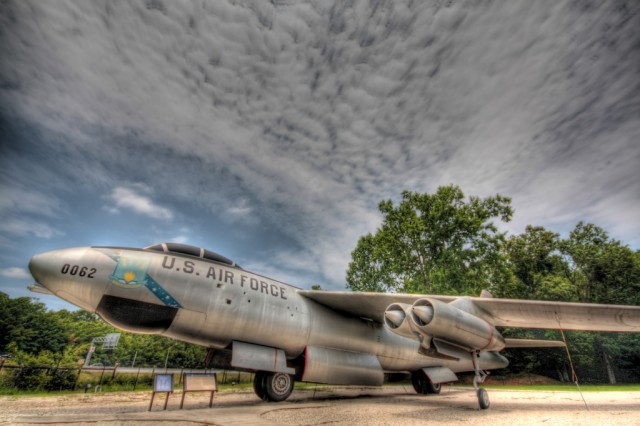
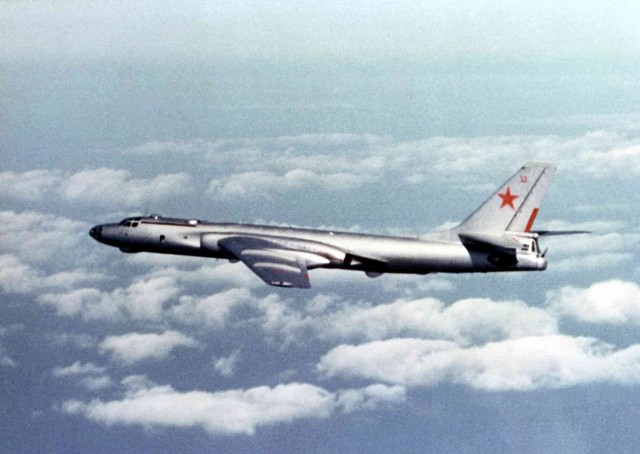
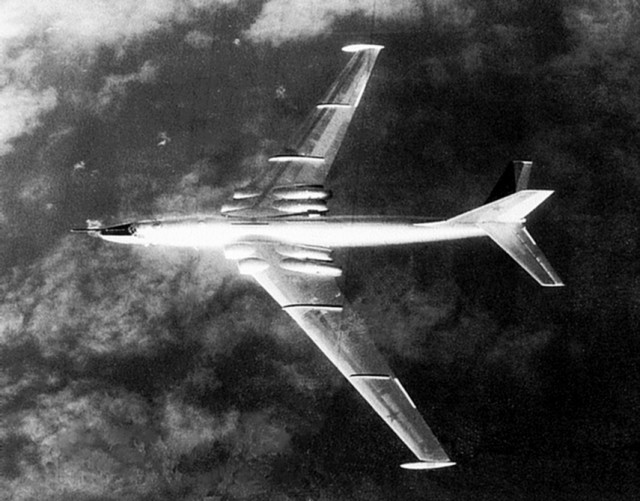
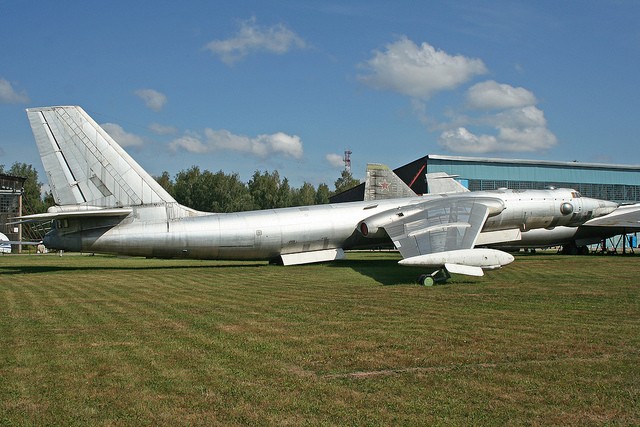
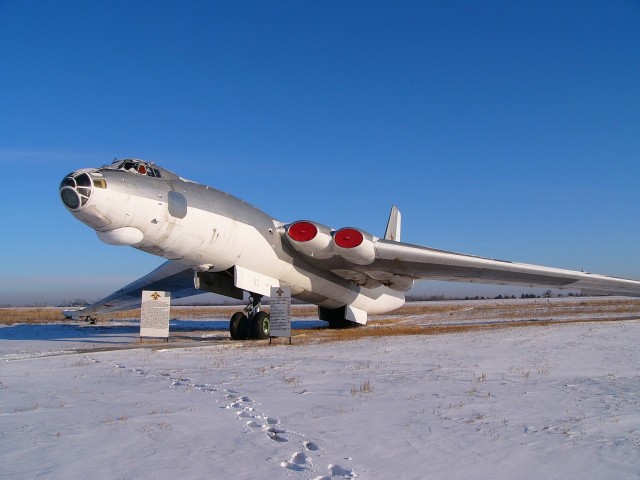
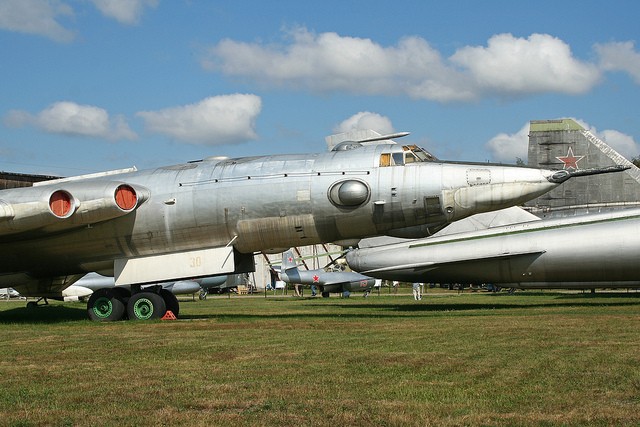
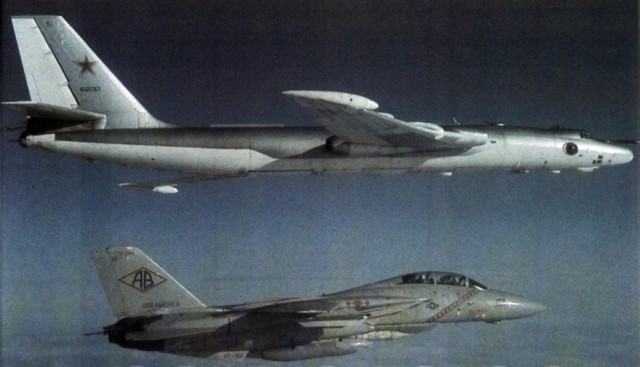
Good looking aircraft!
The Russian classics always have a look about them don’t they?
David, AirlineReporter